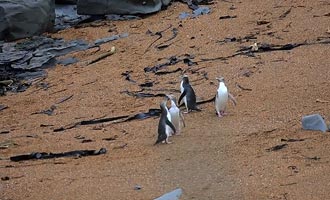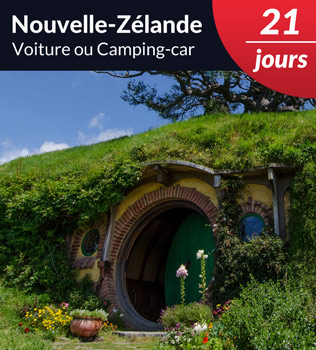
The Mysterious Origin of the Moeraki Boulders.
Please contact us and we will help you to organize your trip! It's free and without commitment.
- Read the post
- Details
- Advices
Schedule of the Visit.
- 1A Day at the Moeraki Boulders.
- 2Do They Come from Space?
- 3Climb on the Boulders.
- 4Penguins and Fur Seals.
- 5A Beach Full of Surprises.
A Day at the Moeraki Boulders.
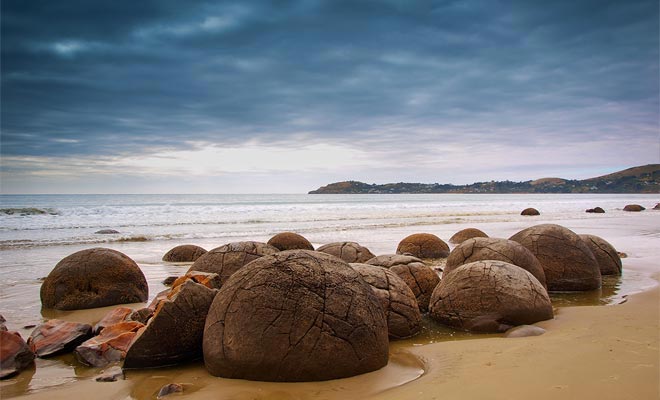
The boulders are visible on the beach at low tide.
A short but essential stop of any trip in New Zealand, the Moerakis boulders continue to fascinate tourists as well as the Pancake Rocks or the arch of Cathedral Cove.
Over a thousand years ago, Maori navigators arrived to New Zealand from “Hawaiki”, the land of the ancestors.
A canoe was left isolated during a terrible storm and ran aground on the coast.
The remains of the canoe and the survivors turned into stone.
The exact location of the legendary wreck is in the South Island of New Zealand. It is north of Otago, on the Koekohe beach where the Moeraki Boulders are located.
Eel baskets metamorphosed (according to the legend), they are perfectly smooth and rounded stones.
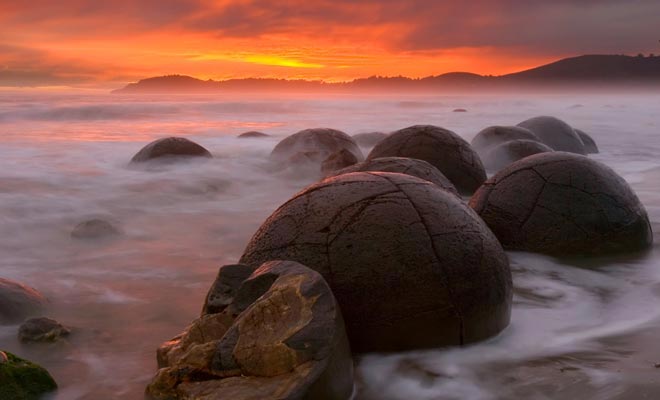
When the mist covers the beach, it feels like another planet.

A complete audioguide that presents the originality of the Moeraki Boulders.
A documentary by ManatuTaonga.Similar to cannonballs, the small rocks have an average circumference of 50 cm. But the biggest ones easily reach two meters and weigh 7 tons!
At the end of the day when the sun disappears from the horizon, golden light invades the beach and the waves gradually cover the stones. One would believe to be passing by the skulls of some giants buried under the sand.
How has nature been able to form such perfect geometric figures?
Do They Come from Space?

Some rocks look like turtle shells...
I've collected all kinds of fantastic hypotheses during my trips. Some rocks are covered with some kind of turtle shells. When the fog lifts, we shiver at the view of these eggs ready to hatch.
By questioning the café owner located a little bit further, I learn about different beautiful nicknames given to these strange stones.
Some call them “jawbreakers” in reference to large chewing-gum balls. Other nicknames are far less poetic and more evocative if you see what I mean… If you look at the surrounding hills, you will discover other boulders starting to emerge (waiting to come rolling on the beach).
Over time, I have collected quite a collection of amusing theories about their formation.
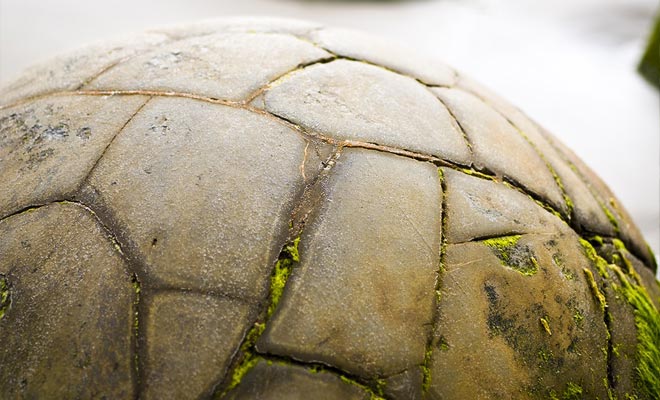
Others look like a football.
We’ll start with the most far-fetched: an alien species left these eggs, which didn’t survive the climate (at least it makes you laugh).
For others, it would be an unknown species of dinosaur eggs.
At first sight preposterous, this hypothesis has found its defenders. Especially since dinosaur skeletons were discovered nearby (a mosasaurus and a plesiosaurus, Cretaceous reptiles!).
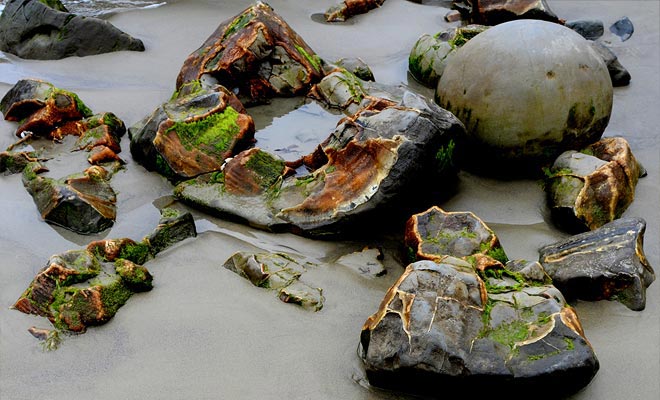
The inside of the boulders looks like egg yolk ...
I’ll ignore biblical theories and other nonsense stories about fireballs fallen from the sky (we are not on Discovery Channel...). But some rocks are split and their content is quite amazing: a heart of stone, honey color, which evokes a fossilized egg indeed.
Of course, scientists investigate, and some theories have been formulated to explain the mystery.

Erosion causes new boulders to emerge from cliffs.
This would actually be deposits of calcite around fossilized mudstones (as usual, the rational explanation is a bit disappointing).
An erosion of 60 million years in the sand would have given this strange spherical shape.
The ocean or the dinosaurs would therefore have no connection with these wonders of nature. One could dare to compare them with the formation of pearls ... seven-ton pearls in this case.
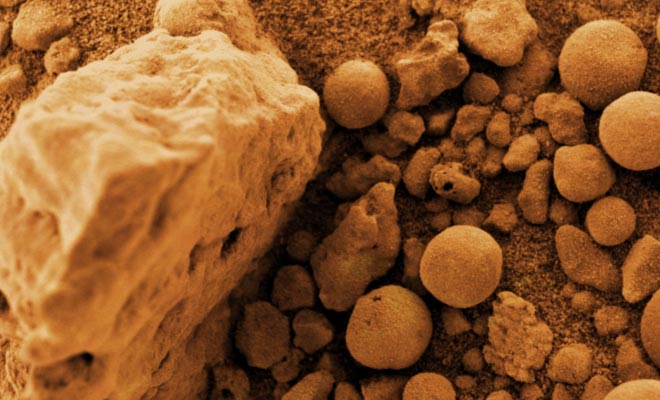
The resemblance to the blueberry rocks on Mars is strange.
The recent discovery of similar structures on Mars (nicknamed the blueberry rocks) reopened the debate.
Dr. CJ Ransom has managed to reproduce similar shapes on a smaller scale. Exposition of dust particles to powerful electrical fields created similar small boulders.
But even the best scientific explanation does not yet reveal everything yet.
How is it possible to explain that the rocks are completely spherical, while their base should be compacted? Is such a perfect spherical form possible after million years under water?
Climb on the Boulders.
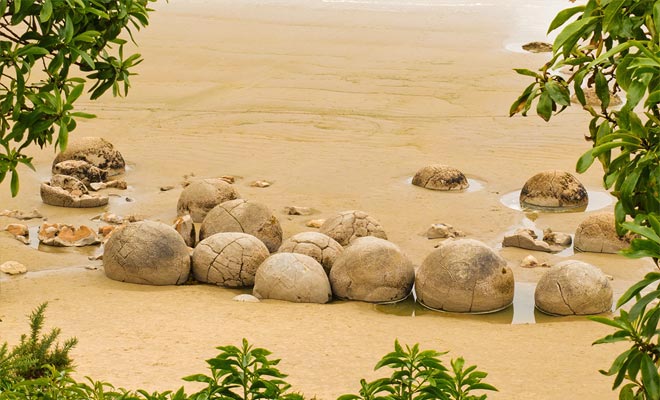
A game of petanque for giants?
There are fifty boulders (or skulls, or dinosaur eggs… it’s up to you) if I counted correctly... Don’t forget your camera, the photogenic beach is very beautiful.
Meanwhile, kids will enjoy to climb on big boulders. Some are hollow and you could even play hide and seek inside.
It’s fun to jump from one stone to another. However, be careful not to slip especially when the waves are close to you!
In this regard, I was particularly lucky during my first visit since I arrived at low tide.
Hours later, the boulders were covered by the ocean. In these circumstances, and if the weather is agitated, there is nothing to be seen and you’ll leave the beach being frustrated.

The perfection of some boulders remains mysterious ...
The Moeraki Boulders are within an hour’s drive from Dunedin. Just remember to get some information about the tides before scheduling your visit. In summer the beach is a bit crowded by tourists, and you should plan to arrive quite early or at the end of the day to fully enjoy the experience.
If the morning comes to an end, you can have a picnic on the beach, but I suggest a better option.
There are two restaurants close to the boulders. The tavern will do, but it would be a crime not to visit “La Fleur”.
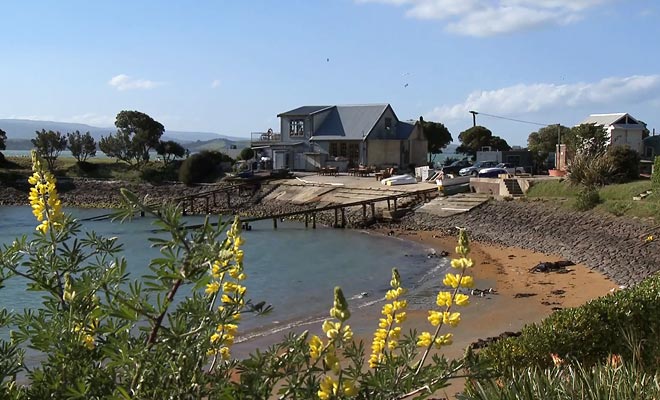
The gourmet restaurant "La Fleur" is a must.
“Fleur's place” is often named among the best restaurants of the country, highly praised throughout New Zealand.
People travel far to taste the Muttonbird, a seabird with smoky taste. The fish pass directly from the fisherman to the cook without any intermediary.
A culinary experience to try for sure, but that involves booking far in advance (you’ll find more information in Ben’s useful tips at the end of the article).
Penguins and Fur Seals.
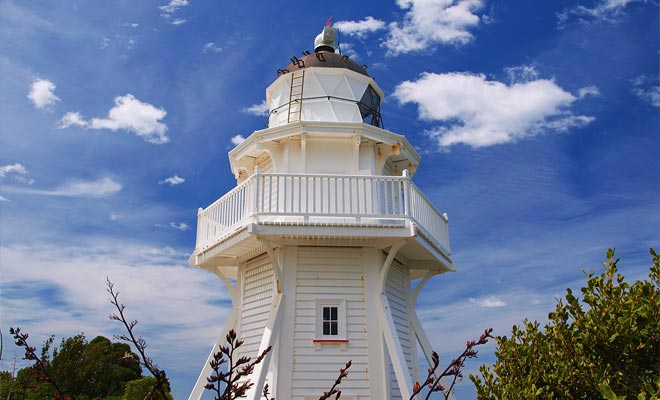
The lighthouse of Katiki is a few kilometers from Moeraki.
A decision needs to be taken. The Koekohe Beach, where the Moeraki boulders are located, is 78 km away from Dunedin and only 35 km from Oamaru. The road is beautiful, everything is well signposted and it is impossible to miss the location.
There's even a campsite right next to it. You may consider the opportunity to spend a few hours there.
To begin, look well across the wide ocean, you're likely to spot Hector's dolphins.
These are not the only “friends” you can make yourself in the region. Look for signs post that indicate the direction towards the Katiki lighthouse. It is a beautiful 5 km hike with a surprise at the end of it.
There is a shelter close to the lighthouse designed to observe yellow-eyed penguins.
If you consider taking the binoculars, you will be able to spy them while they are playing on the beach.
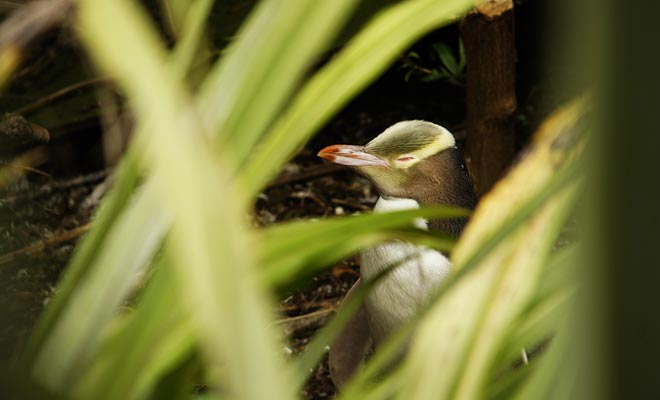
Yellow-eyed penguins can be observed discreetly.
By late afternoon, the penguins leave the water to reach their nests. You will have the opportunity to admire them even closer.
Please however keep in mind that these are wild animals. Do not try to approach them nor giving them the rest of the tuna sandwich you’ve made for the road.
If you have already seen penguins, then head towards Shag Point. The sea lions laze around the rocks and the beach.
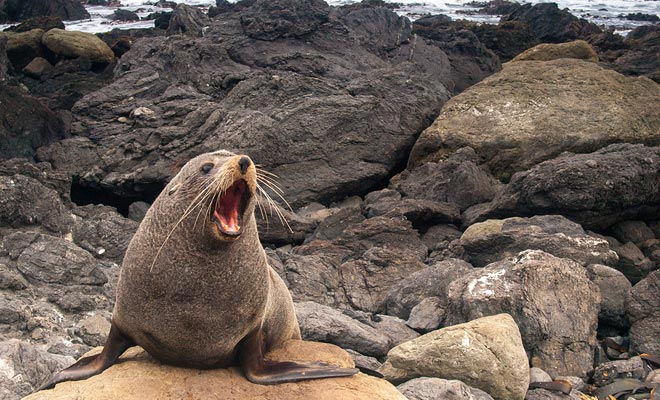
A colony of fur seals is living at Shag Point.
Do you remember the little story I told at the beginning? Observe the rock that stands out at the top. In the Maori legend, it represents the canoe driver that was washed ashore and turned into stone.
Last option: a walk towards the Moeraki village. Count a two-hour round trip along the beach to follow this itinerary.
The ancient whale fishing port was the settlers' first base camp in Otago. This is a good opportunity to stretch the legs before hitting the road for the rest of the trip around New Zealand.
A Beach Full of Surprises.
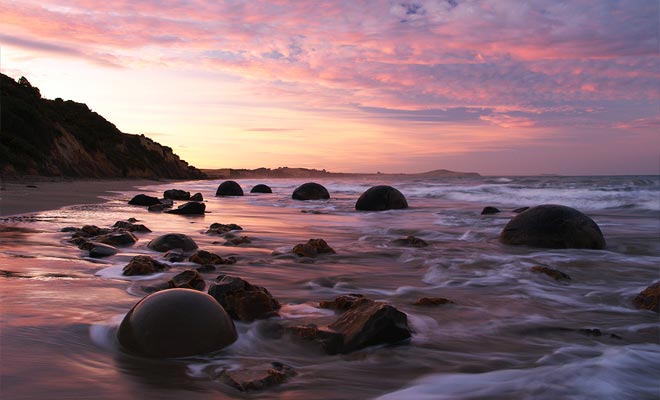
The scientific explanation remains incomplete.
Much more than geological curiosity, the Moeraki Boulders are emblematic of New Zealand. This explains the good position in Kiwipal's ranking of the country's best places. It is unique in the world and worth the visit.
Who knows what lies under the beach? By digging in the sand you may find a plesiosaur skeleton (few where discovered, a few kilometers south in 1987).
A last mystery to solve concerns the missing boulders.
Some photos taken on the beach nearly a century ago reveal the evidence: the boulders decreases, and it has nothing to do with erosion.
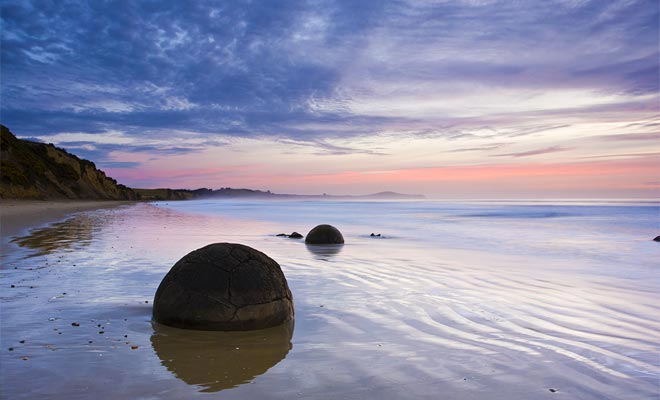
Small boulders were stolen during the past century.
There were many more boulders on the Moeraki beach, but the small and easy-to-transport rocks have been stolen over time, often to decorate gardens.
Although the place is now protected, it continues to be plundered. Thieves break off and carry pieces of the boulders.
This is an even better reason not to postpone your visit: the beach might lost all its magic in few decades.
I have not really addressed the practical matters, but Ben the Kiwi has a better knowledge about the Moeraki Boulders. Check out his FAQ below and you will learn that there are other boulders to be found in New Zealand (including the “Split Apple Rock” of Abel Tasman).
As for us, if you continue your journey south, we will meet again in the beautiful city of Dunedin..


Questions & Answers.

What can I do for you? If you want my opinion, the Moeraki Boulders are eggs from giant kiwis. But any wacky explanation is welcome. Feel free to ask me your questions, I know the place quite well.
- All topics ... 12 answers in total
- The Boulders and Their Origins 5 answers
- Reception and Information 3 answers
- Weather and Tides Schedule 2 answers
- The Beach of Moeraki 2 answers
The Boulders and Their Origins
- Can other boulders be found in New Zealand?
There are indeed other Boulders in New Zealand. The Koutu Boulders and the Wairere Boulders. We'll talk about all this in a future article about Kiwipal.
- Are there other boulders in the world?
Yes, but they are not as famous. Specimens exist in Costa Rica, Russia and Argentina.
- What sites do you recommend to get more information?
There is a superb site to admire the boulders in 360 °, and a remarkable explanatory video:More infos about Moeraki Boulders
- Who did the graffiti on some boulders?
No doubt from those same people who write their name on trees with a knife, or leave their telephone number in the public restroom ...
- Why are some boulders broken up into small pieces?
In some cases, this is quite natural, because of the erosion. But people also used explosives to break up the boulders and resell pieces.
Reception and Information
- How to get there ?
When you leave Oamaru you join the SH1, direction Dunedin. Two routes are available to you. Totara Estate or the coast of Taranui offers splendid landscapes. Both roads join Maheno and its Anglican church. The church has charm and stained-glass windows that come from Rome. If you leave Dunedin, you have 78 km to drive, the distance to the Moerakis boulders are indicated regularly.
- Is it paying?
When you arrive by road you have to stop at the first indicated parking. It allows access to the beach and the Moeraki boulders are at 300m. It's free. If you push to the cafe, you will find that access to the beach is subject to charges. The tariff is fixed at 2 dollars and it is optional (you deposit the money in a box). I don't see why you should pay to visit a beach...
- Where to get souvenirs?
The Moeraki Boulder's Café is open from 9 am to 5 pm. Impossible to miss it, because its roof resembles giant boulders. You will find guides on the formation of the strange stones. There are souvenir gifts similar to the ones you may find in any other souvenir shops in the country.
Weather and Tides Schedule
- What's the weather like in Moeraki?
In the summer you can expect 12 ° C in the morning and 17 ° C in the afternoon. The average descends slowly over the year to reach 6 ° C in the morning and 9 ° C in the afternoon. But you are at the edge of the sea, and the feeling of temperature can vary according to the humidity.Moeraki weather
- Where to find the tide schedule?
Visit this website:Moeraki tides
The Beach of Moeraki
- Can we swim?
The water is too cold to bathe without a combination. The dolphins are sometimes visible offshore, but I advise against swimming here.
- Are there precautions to be taken?
If the tide rises, the boulders can be slippery when they are wet by the waves. You are most likely to get soaked. But the children can get hurt and you must keep an eye on them all the time (as always anyway when they are at the beach).
On the Country Map
Moeraki Beach is located in the Otago region of South Island.

